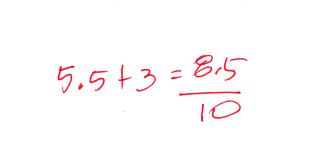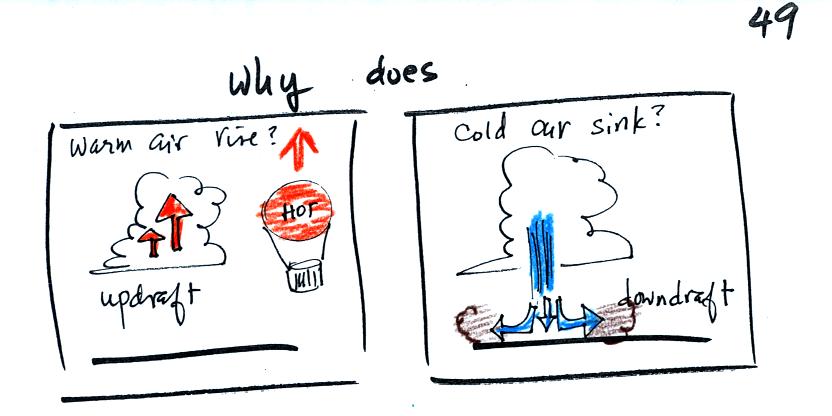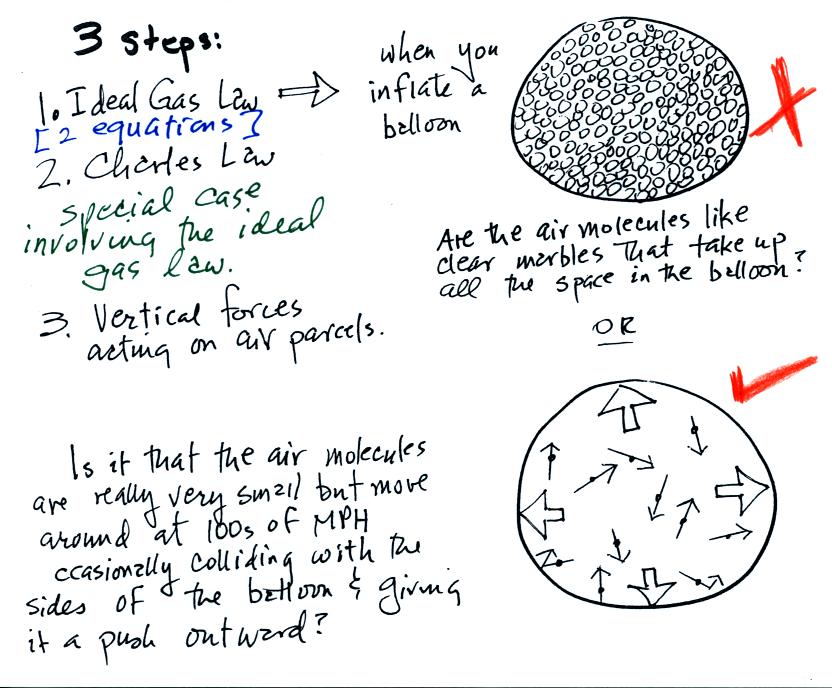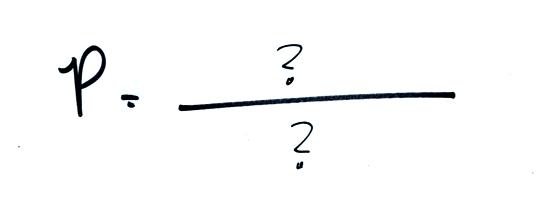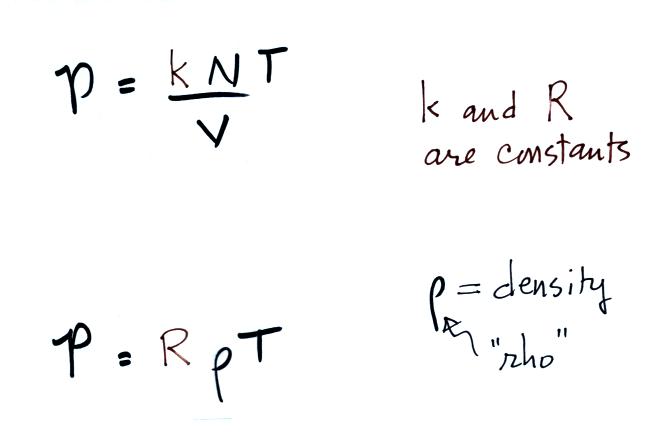Wednesday Feb. 2, 2011
click here to download today's notes in
a more printer friendly format
Three songs from the Fleet
Foxes before class today ("White Winter Hymnal", "Tiger Mountain
Peasant Song", "Mykonos")
The 1S1P Bonus Assignment reports have been graded. The score at
the top of your paper will look something like this:
The first number is the content grade (up to 6 pts possible), the
second is the writing quality grade (4 pts possible). Don't think
of this as 85% (a B). Rather you now have 8.5 pts towards your
goal of earning 45 pts by the
end of the semester.
Some really cold weather is
expected tonight and Thursday night. I may be in a very bad mood
on Friday if all the plants in my vegetable garden freeze.
Brocolli, lettuce, and spinach on the left picture below, snowpeas and
carrots on the
right.
Thursday morning update. Everything in the garden was
frozen stiff this morning (I brushed up against one of the brocolli
plants and part of a leaf just broke off). We'll just have to
wait until everything thaws out to see whether they recover or are just
dead. I probably won't know that until the weekend. So I'm
postponing the bad mood until next week.
Today before the Practice Quiz: the Ideal Gas Law
It is the first step in understanding better why warm air rises
and
cold air sinks.
Hot air balloons rise (they also
sink), so does the relatively
warm air in a thunderstorm (its warmer than the air around
it). Conversely cold air sinks. The surface winds
caused by a thunderstorm downdraft (as shown above) can reach speeds of
100 MPH and are a serious weather hazard.
A full understanding of these rising and sinking motions is
a
3-step process (the following is
from the bottom part of p. 49 in the photocopied ClassNotes)
Well only have time today to learn about the ideal
gas law.
That is an equation that tells you which/how properties of the air
inside a
balloon work to determine the air's pressure. On Friday we will
look
at Charles' Law, a special situation involving the ideal gas law (air
temperature and density change together in a way that keeps the
pressure
inside a balloon constant).
We'll also learn more about the vertical forces that act on air (the
downward gravity force and the upward
pressure difference force)
Students working on Experiment #1 will need to understand the
ideal gas law to be able to explain why/how their experiment works.
The figure above makes an important point: the air molecules in a
balloon "filled with air" really take up very little space. A
balloon filled with air is really mostly empty space. It is the
collisions of the air molecules with the inside walls of the balloon
that keep it inflated.
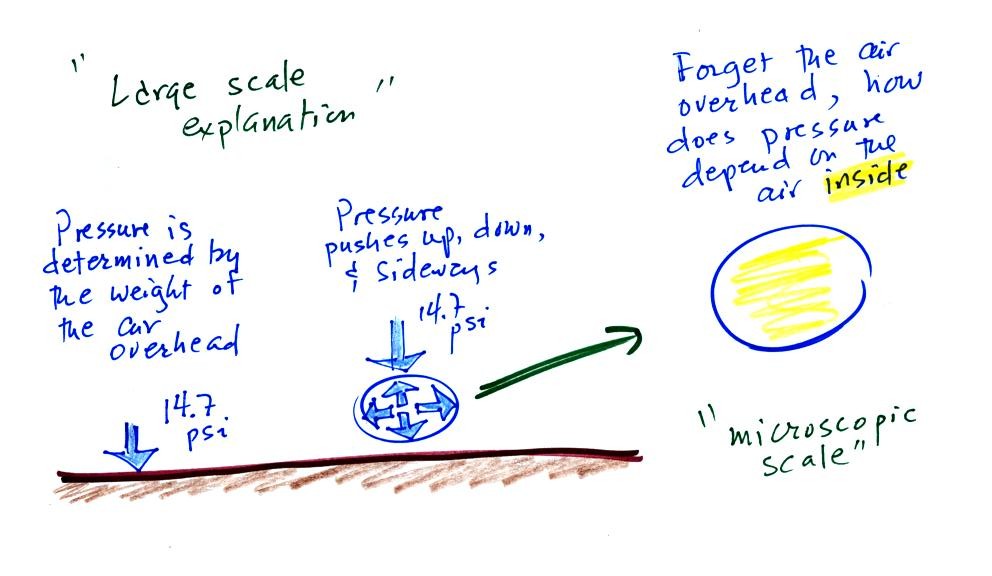
Up to this
point in the semester we
have been thinking of pressure as
being determined
by the weight of the air overhead. Air pressure pushes down
against the ground at sea level with 14.7 pounds of force per square
inch. If you imagine the weight of the atmosphere pushing down on
a balloon sitting on the ground you realize that the air in the balloon
pushes back with the same force. Air everywhere in the atmosphere
pushes upwards, downwards, and sideways.
The ideal gas law
equation is another way of thinking about air pressure, sort of a
microscopic scale version. We ignore
the atmosphere and concentrate on just the air inside the
balloon. We are going to "derive" an equation. Pressure (P)
will be on the left hand side. Relevant properties of the air
inside the
balloon will be found on the right side of the equation.
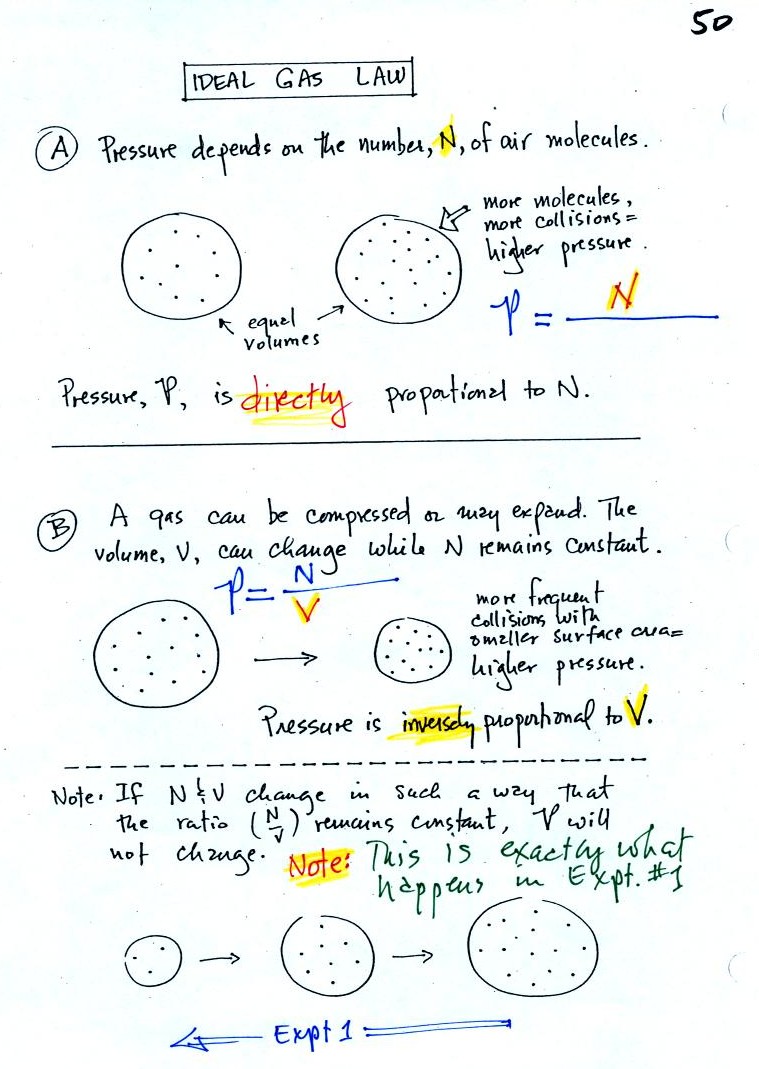
In A
the pressure produced by
the air
molecules inside a balloon will
first depend on how many air molecules are there, N. If there
weren't any air molecules at all there wouldn't be any
pressure. As you add more and more add to something like a
bicycle tire, the
pressure increases. Pressure is directly proportional to N; an
increase in N causes an increase in P. If N doubles, P also
doubles (as long as the other variables in the equation don't change).
In B
air pressure inside a balloon
also
depends on the size of the
balloon. Pressure is inversely proportional to volume, V
. If V were to double, P would drop to 1/2 its original value.
Note
it
is possible to keep pressure constant by changing N and V
together in just the right kind of way. This is what happens in
Experiment #1 that some students are working on. Oxygen in a
graduated cylinder reacts with steel wool to form rust. Oxygen is
removed from the air sample which is a decrease in N. As oxygen
is removed, water rises up into the cylinder decreasing the air sample
volume. N and V both decrease in the same relative amounts and
the air sample pressure remains constant.
If you were to remove 20% of the air molecules, V would decrease
to 20% of its original value and pressure would stay constant.
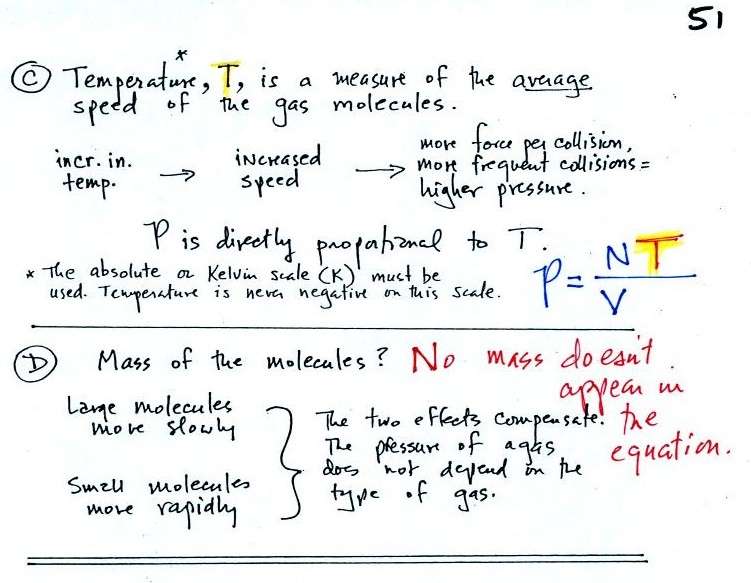
Part C: Increasing
the temperature of the gas in a balloon will cause the gas molecules to
move more quickly. They'll collide with the walls of the balloon
more frequently and rebound with greater force. Both will
increase the pressure. You shouldn't throw a can of spray paint
into a fire because the temperature will cause the pressure inside the
can to increase and the can could explode.
Surprisingly, as explained in Part
D,
the pressure
does
not depend on the mass of the
molecules. Pressure doesn't depend on the composition of the
gas. Gas molecules with a lot of mass will move slowly, the less
massive molecules will move more quickly. They both will collide
with the walls of the container with the same force.
The figure below (which replaces the bottom of p. 51 in the
photocopied
ClassNotes) shows two forms of the ideal gas law. The top
equation is the one we just derived and the bottom is a second slightly
different version. You can
ignore the
constants k and R if you are just trying to understand how a change in
one of the variables would affect the pressure. You only need the
constants when you are doing a calculation involving numbers (which we
won't be doing).
